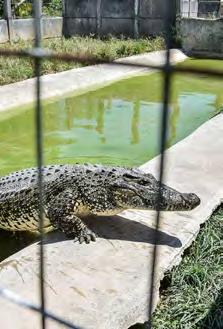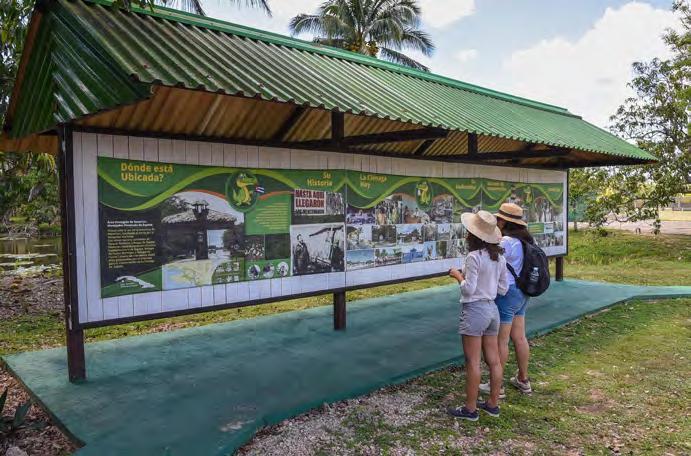
5 minute read
CALIDOSCOPIO
CRIADERO DE COCODRILOS
UN ENCUENTRO CON EL FASCINANTE REPTIL CUBANO
La Ciénaga de Zapata, mayor humedal del Caribe insular, acoge disímiles atractivos que proponen acercar a los visitantes a las maravillas de la naturaleza cubana. Catalogada Sitio Ramsar, Parque Natural y Reserva de la Biosfera, esta península localizada al sur de la provincia Matanzas, constituye el hábitat de una impresionante y variada fauna con alto grado de endemismo. En esta diversidad, destaca una singular especie: el Crocodylus rhombifer o Cocodrilo cubano. Majestuoso y fascinante, puede llegar a medir entre tres y cuatro metros, y pertenece a un grupo de reptiles con más de 70 millones de años de existencia. Ante su peligro de extinción, se han dedicado centros para su cría, reproducción y conservación en cautiverio, así como la reintroducción a las áreas protegidas. Ejemplo de ello, es el Criadero de Cocodrilos gestionado por el grupo Empresarial Flora y Fauna, situado en este enclave matancero.
Crocodile Hatchery

an encounter with this fascinating Cuban reptile
Ciénaga de Zapata, the largest wetland in the Caribbean islands, offers a variety of attractions that bring visitors closer to the wonders of Cuban nature. Classified as a Ramsar Site, Natural Park and Biosphere Reserve, this peninsula located south of Matanzas province is the habitat of an amazing and varied wildlife with a high degree of endemism. In this variety, a singular species stands out: the Crocodylus rhombifer or Cuban Crocodile. Majestic and fascinating, it can measure between three and four meters, and is part of a group of reptiles aged more than 70 million years of existence. In view of its danger of extinction, centers have been set up for its breeding, reproduction and conservation in captivity, as well as its reintroduction to protected areas. An example of this is the Crocodile Hatchery managed by the Flora y Fauna Business Group, located in this site in Matanzas.



El espacio propone, desde un entorno rodeado de hermosa vegetación y zonas pantanosas, un interesante recorrido que promete acercar a los visitantes a las maravillosas criaturas. Con el acompañamiento de excelentes guías, resulta una gran oportunidad para conocer de primera mano, este peculiar reptil endémico de la Isla antillana y adentrarse en su asombroso universo. Agrupados atendiendo a la edad y el tamaño, sorprende observarlos de cerca, imponentes y a la vez serenos, conviviendo juntos entre el agua y la tierra. Es posible detallar la distintiva textura de su piel formada por escamas de un amarillo y negro brillantes, sus ojos prominentes y dientes afilados. El tour es un especial encuentro con las particulares características, comportamientos e historia evolutiva del cocodrilo cubano. Propicia aprender sobre su estudio, salvaguarda y reproducción. Asimismo, los más curiosos u osados podrán interactuar con los pequeños ejemplares y capturar este momento inolvidable en hermosas fotografías.
The site proposes, from an environment surrounded by beautiful vegetation and swampy areas, an interesting tour that brings visitors closer to those wonderful creatures. Along with excellent guides, it is a great opportunity to learn first-hand about this peculiar reptile endemic to Cuba and go into its amazing universe. They are grouped according to age and size and it is surprising to watch them closely, imposing and at the same time calm, living together between water and land. It is possible to detail the distinctive texture of their skin formed by bright yellow and black scales, their prominent eyes and sharp teeth. The tour is a special encounter with the particular features, behavior and evolution of the Cuban crocodile. It is an opportunity to learn about its study, protection and reproduction. Also, the most curious or daring people will be able to interact with the small crocodiles and seize this unforgettable moment in beautiful photographs.


De igual forma, en el taller de taxidermia situado allí, el público puede admirar y estudiar estos impresionantes animales naturalizados de forma tal que parecieran estar vivos, resultado del laborioso y dedicado trabajo de los especialistas en esta combinación de arte y ciencia. La institución matancera realiza un importante trabajo en la preservación de este ejemplar de nuestra fauna, que tiene un reducido hábitat. Tal es el caso, que puede encontrarse únicamente en la Península de Zapata y en la Ciénaga de Lanier, en la Isla de la Juventud. Desde este sitio, se contribuye a la protección de la pureza genética del Crocodylus rhombifer, amenazada por el cruzamiento con el llamado caimán americano – ambas especies viven en esta sureña área protegida. Expertos de varias instituciones y centros de investigación nacionales y extranjeros colaboran como parte de un programa para su conservación. La visita al criadero resulta una parada necesaria si de recorrer la Ciénaga se trata. Convida a una emocionante aventura, a descubrir de cerca al emblemático cocodrilo cubano.
Likewise, in the taxidermy workshop located there, people can admire and study those impressive animals that have been worked on in such a way that they appear to be alive, the result of the laborious and dedicated work of specialists in this combination of art and science. The Crocodile Hatchery carries out an important work in the preservation of this specimen of our wildlife, which has a reduced habitat. Such is the case that it can only be found in Peninsula de Zapata and Cienaga de Lanier, in Isla de la Juventud. This site contributes to the protection of the genetic purebred nature of the Crocodylus rhombifer, threatened by crossbreeding with the so-called American caiman - both species live in this southern protected area. Experts from several national and foreign institutions and research centers collaborate as part of a program for their conservation. A visit to the hatchery is a necessary stop if you are touring Cienaga de Zapata. It proposes an exciting adventure to discover the emblematic Cuban crocodile.









